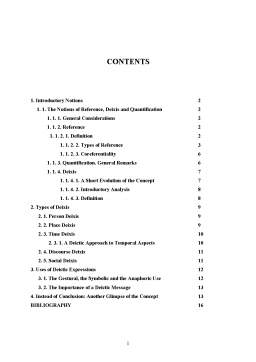Cuprins
- 1. Introductory Notions 2
- 1. 1. The Notions of Reference, Deixis and Quantification 2
- 1. 1. 1. General Considerations 2
- 1. 1. 2. Reference 2
- 1. 1. 2. 1. Definition 2
- 1. 1. 2. 2. Types of Reference 3
- 1. 1. 2. 3. Coreferentiality 6
- 1. 1. 3. Quantification. General Remarks 6
- 1. 1. 4. Deixis 7
- 1. 1. 4. 1. A Short Evolution of the Concept 7
- 1. 1. 4. 2. Introductory Analysis 8
- 1. 1. 4. 3. Definition 8
- 2. Types of Deixis 9
- 2. 1. Person Deixis 9
- 2. 2. Place Deixis 9
- 2. 3. Time Deixis 10
- 2. 3. 1. A Deictic Approach to Temporal Aspects 10
- 2. 4. Discourse Deixis 11
- 2. 5. Social Deixis 11
- 3. Uses of Deictic Expressions 12
- 3. 1. The Gestural, the Symbolic and the Anaphoric Use 12
- 3. 2. The Importance of a Deictic Message 13
- 4. Instead of Conclusion: Another Glimpse of the Concept 13
- BIBLIOGRAPHY 16
Extras din referat
1. Introductory Notions
1. 1. The Notions of Reference, Deixis and Quantification
1. 1. 1. General Considerations
The three notions referred to are connected and their interrelations are intuitively not difficult to grasp.
In the process of understanding grammatical categories in general and, in particular, the meaning of the various markers of the categories, reference, deixis and quantification represent essential notions.
1. 1. 2. Reference
1. 1. 2. 1. Definition
Reference is a semantic notion which can be defined as a relation between a semantic unit and an object in reality, therefore a relation holding between language and non-language .
However, an interesting duality arises quite often: language itself can be referred to as non-language. This property is called reflexiveness and in its turn can be applied to two different types of situations. In the first case, language refers to language as an object of study and the term used to call it is meta-language; this is the context when we have to deal with meta-linguistic reference . In this respect, all terms we are using in a grammatical description belong to meta-language, e.g.,
word, morpheme, sentence, etc.
The language of any grammar book is also meta-language. For instance, a description of English can contain the same ideas, irrespective of whether it is written in Romanian or in Russian, or even in English.
In the second case, language refers to samples of language for communication purposes . Thus, one can refer to a stretch of writing or speech, that is to a text, e. g. ,
I talked to Mary yesteday. It was quite interesting. She is very nice.
It refers back to the speaker’s talking, that is to the whole previous sentence. She refers back to Mary; the object referred to by it and she are the portions of text I talked to Vivian and Vivian respectively.
This kind of reference is meant to preserve the cohesion of communication, and in this case, portions of language themselves play the role of objects in reality within the relation of reference. Each reference which ultimately concerns outside reality but is made through language, by means of a text, will be called textual reference .
When studying the grammatical categories we are not so much interested in the notion of reference – a purely semantic notion, as in more specific aspects of reference. Any lexeme, by its semantic content, refers to something in outside reality, but there are also means to provide some more refined kinds of information, apt to show whether the object referred to is already known or unknown, whether it is known because it has been mentioned before or for other reasons, whether it is representative of a large number of objects or just of several or one particular object, whether it has definite identity or its identity is irrelevant for the purpose of communication.
1. 1. 2. 2. Types of Reference
According to the information given above, there are several types of reference:
(1) Generic and non-generic reference. This distinction is made from the point of view of the degree of generality of the objects denoted. We can speak about generic reference when a certain property enounced refers to a whole class of objects, e. g. ,
Children must sleep at least ten hours a day.
One can never know too much and People will always talk, one and people have generic reference.
Non-generic reference is the reference to a particular object or group of objects, e. g.
That child has to go to sleep, in contrast with the first example.
A further distinction can be made. In its turn non-generic reference can be definite or indefinite and, within the two types mentioned above, we can also speak about specific and non-specific reference.
Preview document
Conținut arhivă zip
- Reference, Deixis and Quantification.doc















